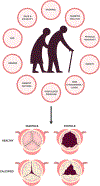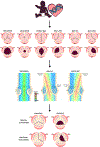Genetic and Developmental Contributors to Aortic Stenosis
- PMID: 33914609
- PMCID: PMC8096202
- DOI: 10.1161/CIRCRESAHA.120.317978
Genetic and Developmental Contributors to Aortic Stenosis
Abstract
Aortic stenosis (AS) remains one of the most common forms of valve disease, with significant impact on patient survival. The disease is characterized by left ventricular outflow obstruction and encompasses a series of stenotic lesions starting from the left ventricular outflow tract to the descending aorta. Obstructions may be subvalvar, valvar, or supravalvar and can be present at birth (congenital) or acquired later in life. Bicuspid aortic valve, whereby the aortic valve forms with two instead of three cusps, is the most common cause of AS in younger patients due to primary anatomic narrowing of the valve. In addition, the secondary onset of premature calcification, likely induced by altered hemodynamics, further obstructs left ventricular outflow in bicuspid aortic valve patients. In adults, degenerative AS involves progressive calcification of an anatomically normal, tricuspid aortic valve and is attributed to lifelong exposure to multifactoral risk factors and physiological wear-and-tear that negatively impacts valve structure-function relationships. AS continues to be the most frequent valvular disease that requires intervention, and aortic valve replacement is the standard treatment for patients with severe or symptomatic AS. While the positive impacts of surgical interventions are well documented, the financial burden, the potential need for repeated procedures, and operative risks are substantial. In addition, the clinical management of asymptomatic patients remains controversial. Therefore, there is a critical need to develop alternative approaches to prevent the progression of left ventricular outflow obstruction, especially in valvar lesions. This review summarizes our current understandings of AS cause; beginning with developmental origins of congenital valve disease, and leading into the multifactorial nature of AS in the adult population.
Keywords: aortic valve; bicuspid aortic valve disease; endothelial cells; extracellular matrix.
Conflict of interest statement
Figures


Similar articles
-
Left Ventricular Outflow Tract Obstruction in Aortic Arch Anomalies With Ventricular Septal Defect.Ann Thorac Surg. 2016 Jun;101(6):2302-8. doi: 10.1016/j.athoracsur.2015.12.048. Epub 2016 Mar 4. Ann Thorac Surg. 2016. PMID: 26952292
-
Should a bicuspid aortic valve be replaced in the presence of subvalvar or supravalvar aortic stenosis?Ann Thorac Surg. 1998 Oct;66(4):1337-42. doi: 10.1016/s0003-4975(98)00797-8. Ann Thorac Surg. 1998. PMID: 9800830
-
The Ross, Konno, and Ross-Konno operations for congenital left ventricular outflow tract abnormalities.Cardiol Young. 2014 Dec;24(6):1121-33. doi: 10.1017/S1047951114002042. Cardiol Young. 2014. PMID: 25647390 Review.
-
Echocardiographic evaluation of congenital left ventricular outflow obstruction.Echocardiography. 2015 Jan;32 Suppl 2:S140-7. doi: 10.1111/echo.12181. Epub 2014 May 29. Echocardiography. 2015. PMID: 24891121 Review.
-
[Nonrheumatic calcification of the mitral valve in patients with stenotic calcified bicuspid aortic valve].J Cardiol. 1996 Oct;28(4):221-6. J Cardiol. 1996. PMID: 8934338 Japanese.
Cited by
-
The Associations of Aortic Valve Sclerosis, Aortic Annular Increased Reflectivity, and Mitral Annular Calcification with Subsequent Aortic Stenosis in Older Individuals: Findings from the Cardiovascular Health Study.J Am Soc Echocardiogr. 2023 Jan;36(1):41-49.e1. doi: 10.1016/j.echo.2022.08.013. Epub 2022 Sep 10. J Am Soc Echocardiogr. 2023. PMID: 36096340 Free PMC article.
-
Introduction to the Aortic Valve Disease Review Series.Circ Res. 2021 Apr 30;128(9):1327-1329. doi: 10.1161/CIRCRESAHA.121.319286. Epub 2021 Apr 29. Circ Res. 2021. PMID: 33914602 Free PMC article. No abstract available.
-
Navigating the Landscape of Translational Medicine of Calcific Aortic Valve Disease: Bridging Bench to Bedside.JACC Asia. 2025 Apr;5(4):503-515. doi: 10.1016/j.jacasi.2025.01.014. JACC Asia. 2025. PMID: 40180541 Free PMC article. Review.
-
Liraglutide Attenuates Aortic Valve Calcification in a High-Cholesterol-Diet-Induced Experimental Calcific Aortic Valve Disease Model in Apolipoprotein E-Deficient Mice.J Cardiovasc Dev Dis. 2023 Sep 6;10(9):386. doi: 10.3390/jcdd10090386. J Cardiovasc Dev Dis. 2023. PMID: 37754815 Free PMC article.
-
β-Catenin regulates endocardial cushion growth by suppressing p21.Life Sci Alliance. 2023 Jun 29;6(9):e202302163. doi: 10.26508/lsa.202302163. Print 2023 Sep. Life Sci Alliance. 2023. PMID: 37385754 Free PMC article.
References
-
- Pujari SH and Agasthi P. Aortic Stenosis StatPearls Treasure Island (FL); 2020. - PubMed
-
- Goody PR, Hosen MR, Christmann D, Niepmann ST, Zietzer A, Adam M, Bonner F, Zimmer S, Nickenig G and Jansen F. Aortic Valve Stenosis: From Basic Mechanisms to Novel Therapeutic Targets. Arterioscler Thromb Vasc Biol. 2020;40:885–900. - PubMed
-
- Bellamy MF, Pellikka PA, Klarich KW, Tajik AJ and Enriquez-Sarano M. Association of cholesterol levels, hydroxymethylglutaryl coenzyme-A reductase inhibitor treatment, and progression of aortic stenosis in the community. J Am Coll Cardiol. 2002;40:1723–30. - PubMed
Publication types
MeSH terms
Grants and funding
LinkOut - more resources
Full Text Sources
Other Literature Sources
Research Materials

